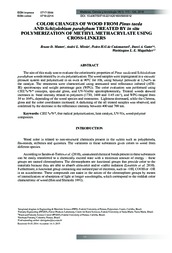Color changes of wood from Pinus taeda and Schizolobium parahybum treated by in situ polymerization of methyl methacrylate using cross-linkers.
Color changes of wood from Pinus taeda and Schizolobium parahybum treated by in situ polymerization of methyl methacrylate using cross-linkers.
Author(s): MATTOS, B. D.; MISSIO, A. L.; CADEMARTORI, P. H. G. de; GATTO, D. A.; MAGALHAES, W. L. E.
Summary: The aim of this study was to evaluate the colorimetric properties of Pinus taeda and Schizolobium parahybum woods treated by in situ polymerization. The wood samples were impregnated in a vacuum/ pressure system and polymerized in an oven at 90°C for 10h, using benzoyl peroxide at 1,5wt% as the catalyst. The treatments were characterized using attenuated total reflectance infrared (ATRIR) spectroscopy and weight percentage gain (WPG). The color evaluation was performed using CIEL*a*b* concepts, specular gloss, and UV-Visible spectrophotometry. Treated woods showed increases in band intensity related to polymers (1730, 1460 and 1145 cm-1), and WPG ranged from 39 to 164%, depending of the wood species and treatments. Lightness decreased, while the Chroma, gloss and the color coordinates increased. A darkening of the all treated samples was observed, and confirmed by the decrease in the reflectance intensity between 400 and 700 nm.
Publication year: 2016
Types of publication: Journal article
Unit: Embrapa Forestry
Observation
Some of Embrapa's publications are published as ePub files. To read them, use or download one of the following free software options to your computer or mobile device. Android: Google Play Books; IOS: iBooks; Windows and Linux: Calibre.
Access other publications
Access the Agricultural Research Database (BDPA) to consult Embrapa's full library collection and records.
Visit Embrapa Bookstore to purchase books and other publications sold by Embrapa.

